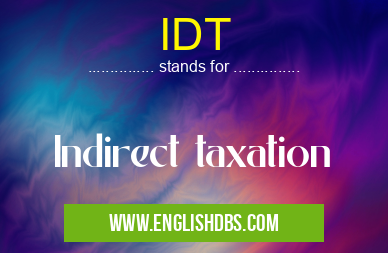What does IDT mean in TAX
IDT stands for Indirect Taxation, a critical component of fiscal systems worldwide. It refers to taxes that are levied on the consumption or production of goods and services, rather than directly on income or property.

IDT meaning in Tax in Business
IDT mostly used in an acronym Tax in Category Business that means Indirect taxation
Shorthand: IDT,
Full Form: Indirect taxation
For more information of "Indirect taxation", see the section below.
Types of Indirect Taxes
Indirect taxes encompass a range of levies, including:
- Value-Added Tax (VAT): Applied to the value added at each stage of production and distribution.
- Goods and Services Tax (GST): A comprehensive tax on the supply of most goods and services.
- Excise Duties: Taxes on specific commodities, such as alcohol, tobacco, and fuel.
- Customs Duties: Taxes levied on goods imported or exported.
Benefits of Indirect Taxation
Indirect taxes offer several benefits:
- Broad Tax Base: They capture a wide range of consumption and production activities.
- Revenue Generation: IDT is a significant revenue generator for governments.
- Progressive: Can be structured to place a greater burden on those with higher consumption.
- Economic Efficiency: Encourages efficient resource allocation and discourages wasteful consumption.
Challenges of Indirect Taxation
While indirect taxes have advantages, they also pose challenges:
- Complexity: IDT systems can be complex and burdensome for businesses to comply with.
- Cascading Effect: Taxes applied at multiple stages can lead to higher prices for consumers.
- Evasion and Avoidance: Indirect taxes can be prone to evasion and avoidance, reducing revenue collection.
- Regressive Nature: Certain forms of IDT, such as excise duties, can disproportionately impact lower-income households.
Essential Questions and Answers on Indirect taxation in "BUSINESS»TAX"
What is Indirect Taxation (IDT)?
Indirect Taxation (IDT) refers to a system of taxation where the burden of tax is shifted from the final consumer to an intermediary, such as a business or retailer. The tax is initially borne by the intermediary but is ultimately passed on to the consumer through the price of goods or services.
How does IDT operate?
In IDT, the tax is levied on various stages of production or distribution, including manufacturing, wholesale, and retail. The intermediary collects the tax from the consumer and pays it to the government. The tax is then passed on to the consumer through an increase in the price of the goods or services.
What are the key features of IDT?
Key features of IDT include:
- The tax burden is shifted from consumers to intermediaries.
- It is usually levied on specific goods or services.
- It can be imposed on various stages of production or distribution.
- It generally requires intermediaries to register and file tax returns.
What are the different types of IDT?
Common types of IDT include:
- Value Added Tax (VAT)
- Sales Tax
- Excise Duty
- Customs Duty
What are the advantages of IDT?
Advantages of IDT include:
- Broad tax base, leading to potentially higher revenue collection.
- Reduced tax evasion, as the tax is collected at multiple stages.
- Flexibility in targeting specific goods or services.
- Administrative efficiency, as the tax is collected by intermediaries.
What are the disadvantages of IDT?
Disadvantages of IDT include:
- Regressive nature, as it can disproportionately impact low-income consumers.
- Potential for cascading effects, where tax is imposed on the same goods or services at multiple stages.
- Administrative burden for intermediaries, who are responsible for tax collection and remittance.
- Possibility of tax avoidance or fraud by intermediaries.
Final Words: Indirect Taxation plays a vital role in fiscal systems by generating revenue, influencing economic behavior, and ensuring fairness. By understanding its types, benefits, and challenges, policymakers can design IDT systems that effectively balance revenue needs with economic and social considerations.
IDT also stands for: |
|
| All stands for IDT |
